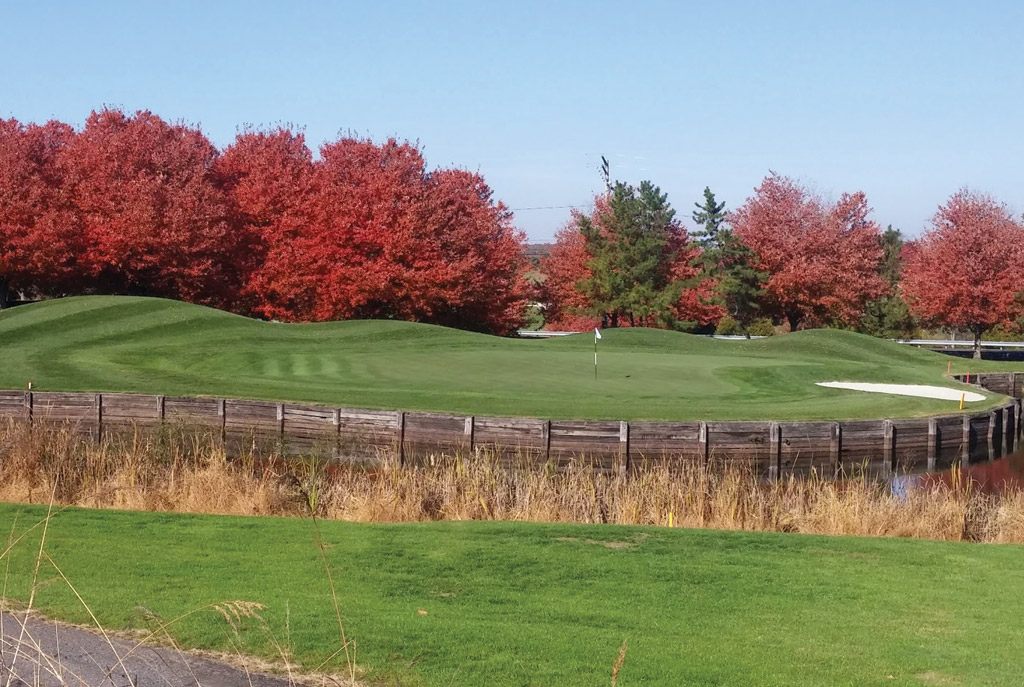[…]impact of nutrient management plans. In Maryland, maintenance P applications must be based on soil test recommendations obtained at least every three years. The University of Maryland Extension maintains a list of soil test laboratories and guidance on conducting soil tests (see Selecting and Using a Soil Test Laboratory. 2013. University of Maryland). Best Management Practices Divide the course into logical components such as greens, fairways, tees, and roughs. In addition, do not combine samples from areas that have different past management histories, exhibit different problems, or have different turfgrass species. Ten to 15 soil samples should be randomly taken from […]
[…]plants and algae in ponds in Maryland, see Urban and Stormwater Pond Management and see Plants Recommended for Stormwater Ponds for Maryland-specific native aquatic plant recommendations. Best Management Practices Ponds are more resistant to problems if they have a narrow fringe of vegetation along the edge, instead of highly maintained turfgrass. In ponds with littoral plantings, problem plants should be selectively controlled without damaging littoral shelves. Encourage clumps of native emergent vegetation at the shoreline. A comprehensive management plan should include strategies to control the growth of nuisance vegetation that can negatively affect a pond’s water quality and treatment capacity. […]
[…]could hold water. Remove water from all conveyances and supply and distribution devices that may freeze by using compressed air or opening drain valves at the lowest point on the system. Clean filters, screens, and housing. Remove drain plugs and empty water out of the system. Secure systems and close and lock covers/compartment doors to protect the system from potential acts of vandalism and from animals seeking refuge. Remove drain plugs and drain above-ground pump casings. Record metering data before closing the system. Secure or lock irrigation components and electrical boxes. Perform pump and engine servicing/repair before winterizing. Recharge irrigation […]
[…]essential for satisfactory turfgrass growth and performance. Phosphorus is particularly critical for new sites being established from seed, or for overseeding turf during renovation projects. Established turf, however, can generally tolerate relatively low levels of soil P. Natural organic fertilizers that contain P cannot be applied to turfgrass areas that have soil test P levels measuring optimum or excessive. On turfgrass that has low or medium soil P levels, natural organic fertilizers cannot be applied in excess of the amount of P recommended by the soil test, cannot be applied at a rate of more than 0.25 pounds of P205 […]
[…]as formulated. To avoid contamination, PPE should not be stored in a pesticide storage area. For more information, see Chapter 6 “Personal Protective Equipment” of the Maryland Pesticide Applicator Core Manual. Best Management Practices Provide adequate PPE for all employees who work with pesticides (including equipment technicians who service pesticide application equipment). Ensure that PPE is sized appropriately for each person using it. Make certain that PPE is appropriate for the chemicals used as listed on the pesticide label. Ensure that PPE meets rigorous testing standards and is not just the least expensive. Store PPE where it is easily accessible […]
[…]P application if an existing turfgrass area is being overseeded but the area is not being tilled. For example, overseeding existing tees or fairways using a slicer-seeder would require a soil test before P can be applied. No P can be applied between to a seedbed or an area to be sodded between November 15 and March 1. No N can be applied to a seedbed or an area to be sodded between December 1 and March 1. Between November 15 and November 30, 0.5 pounds actual N per 1000 ft2 can be applied, but only using a soluble N […]
[…]valuable recognition for their environmental education and certification efforts. Best Management Practices Obtain and review materials to ascertain whether the facility should seek certification. Work with staff to establish facility goals that lead to certification. Establish goals to educate members about the certification program. Next: […]
[…]speed recovery. Light and frequent topdressing is important for maintaining a smooth, firm, and uniform playing surface throughout the season, although research has also illustrated that it protects the plant crown from heat and drought stress, equipment traffic, and disease. This supplemental application of sand is also important to do regularly in order to reduce layering in the thatch profile and maintain good water-infiltration rates. Frequency should depend on turfgrass growth potential but can be done as often as weekly. Timing these applications just prior to rain or a deep irrigation cycle can help incorporate the sand into the canopy […]
[…]is designated as the lead agency for enforcement of the Maryland Pesticide Applicators Law (COMAR 15.05.01). As such, MDA is responsible for: Regulating the use, sale, storage, and disposal of pesticides. Certifying pesticide applicators. Ensuring that pesticides are applied by competent individuals. Establishing guidelines for the application of pesticides. In addition to federal registration as required under FIFRA, all pesticide products distributed, sold, or transported in Maryland must be registered with the MDA’s State Chemist Section. The Maryland Pesticide Registration and Labeling Law requires a distributor of a pesticide product to register every pesticide product each year with the State […]
[…]ground cover and in which herbicides are intelligently selected and judiciously used when needed. For more information on controlling weeds in Maryland, including herbicide recommendations, see: Broadleaf Weed Control in Established Lawns. 2005. University of Maryland. Herbicides for Crabgrass and Goosegrass Control in Turf. 2008. University of Maryland. Guide to Controlling Weeds in Cool Season Turf. 2016. University of Maryland Extension. Best Management Practices To prevent weed encroachment, adopt or maintain cultural practices that protect turfgrass from environmental stresses such as shade, drought, and extreme temperatures. To reduce weed infestation, address improper turf management practices, such as the misuse of […]

